1. Castelli WP. The triglyceride issue: a view from Framingham. Am Heart J. 1986. 112:432–437.
2. Jee SH, Suh I, Kim IS, Appel LJ. Smoking and atherosclerotic cardiovascular disease in men with low levels of serum cholesterol: the Korea Medical Insurance Corporation Study. JAMA. 1999. 282:2149–2155.
3. Toth PP. Subclinical atherosclerosis: what it is, what it means and what we can do about it. Int J Clin Pract. 2008. 62:1246–1254.
4. Anderson KM, Castelli WP, Levy D. Cholesterol and mortality. 30 years of follow-up from the Framingham study. JAMA. 1987. 257:2176–2180.
6. Korea National Statistical Office. Annual report on the cause of death statistics, 2006. 2007. Daejeon: Korea National Statistical Office.
7. Lim SJ, Kim HJ, Nam CM, Chang HS, Jang YH, Kim S, Kang HY. Socioeconomic costs of stroke in Korea: estimated from the Korea national health insurance claims database. J Prev Med Public Health. 2009. 42:251–260.
8. Korea Health Industry Development Institute. Ministry of Health and Welfare. The Third Korea National Health and Nutrition Examination Survey (KNHANES III), 2005. 2006. Seoul: Ministry of Health and Welfare.
9. Expert Panel on Detection, Evaluation, and Treatment of High Blood Cholesterol in Adults. Executive summary of the third report of the National Cholesterol Education Program (NCEP) Expert Panel on Detection, Evaluation, and Treatment of High Blood Cholesterol in Adults (Adult Treatment Panel III). JAMA. 2001. 285:2486–2497.
10. Friedewald WT, Levy RI, Fredrickson DS. Estimation of the concentration of low-density lipoprotein cholesterol in plasma, without use of the preparative ultracentrifuge. Clin Chem. 1972. 18:499–502.
11. Castelli WP. Cholesterol and lipids in the risk of coronary artery disease: the Framingham Heart Study. Can J Cardiol. 1988. 4:Suppl A. 5A–10A.
12. Stamler J, Wentworth D, Neaton JD. Is relationship between serum cholesterol and risk of premature death from coronary heart disease continuous and graded? Findings in 356,222 primary screenees of the Multiple Risk Factor Intervention Trial (MRFIT). JAMA. 1986. 256:2823–2828.
13. Haim M, Benderly M, Brunner D, Behar S, Graff E, Reicher-Reiss H, Goldbourt U. Elevated serum triglyceride levels and long-term mortality in patients with coronary heart disease: the Bezafibrate Infarction Prevention (BIP) Registry. Circulation. 1999. 100:475–482.
14. Expert Panel on Detection, Evaluation, and Treatment of High Blood Cholesterol in Adults. Summary of the second report of the National Cholesterol Education Program (NCEP) Expert Panel on Detection, Evaluation, and Treatment of High Blood Cholesterol in Adults (Adult Treatment Panel II). JAMA. 1993. 269:3015–3023.
16. Turner RC, Millns H, Neil HA, Stratton IM, Manley SE, Matthews DR, Holman RR. Risk factors for coronary artery disease in non-insulin dependent diabetes mellitus: United Kingdom Prospective Diabetes Study (UKPDS: 23). BMJ. 1998. 316:823–828.
17. O'Brien T, Nguyen TT. Lipids and lipoproteins in women. Mayo Clin Proc. 1997. 72:235–244.
18. Barrett-Connor E, Bush TL. Estrogen replacement and coronary heart disease. Cardiovasc Clin. 1989. 19:159–172.
19. Jensen J, Nilas L, Christiansen C. Influence of menopause on serum lipids and lipoproteins. Maturitas. 1990. 12:321–331.
20. de Aloysio D, Gambacciani M, Meschia M, Pansini F, Bacchi Modena A, Bolis PF, Massobrio M, Maiocchi G, Peruzzi E. The Icarus Study Group. The effect of menopause on blood lipid and lipoprotein levels. Atherosclerosis. 1999. 147:147–153.
21. Korea Health Industry Development Institute. Ministry of Health and Welfare. Report on National Health and Nutrition Examination Survey, 1998. 1999. Seoul: Ministry of Health and Welfare.
22. Korea Health Industry Development Institute. Ministry of Health and Welfare. Report on National Health and Nutrition Examination Survey, 2001. 2002. Seoul: Ministry of Health and Welfare.
23. Ford ES, Mokdad AH, Giles WH, Mensah GA. Serum total cholesterol concentrations and awareness, treatment, and control of hypercholesterolemia among US adults: findings from the National Health and Nutrition Examination Survey, 1999 to 2000. Circulation. 2003. 107:2185–2189.
24. Carroll MD, Lacher DA, Sorlie PD, Cleeman JI, Gordon DJ, Wolz M, Grundy SM, Johnson CL. Trends in serum lipids and lipoproteins of adults, 1960-2002. JAMA. 2005. 294:1773–1781.
25. Arai H, Yamamoto A, Matsuzawa Y, Saito Y, Yamada N, Oikawa S, Mabuchi H, Teramoto T, Sasaki J, Nakaya N, Itakura H, Ishikawa Y, Ouchi Y, Horibe H, Kita T. Serum lipid survey and its recent trend in the general Japanese population in 2000. J Atheroscler Thromb. 2005. 12:98–106.




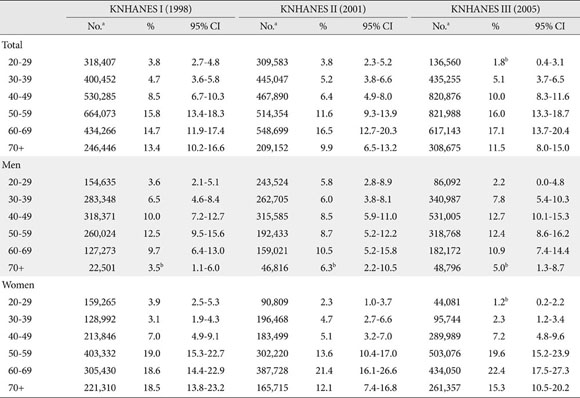
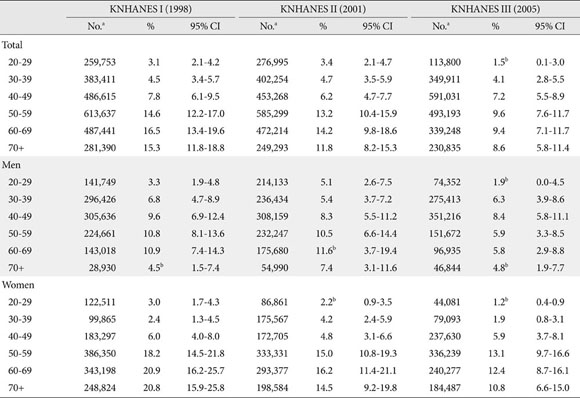




 PDF
PDF ePub
ePub Citation
Citation Print
Print



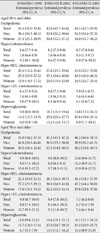
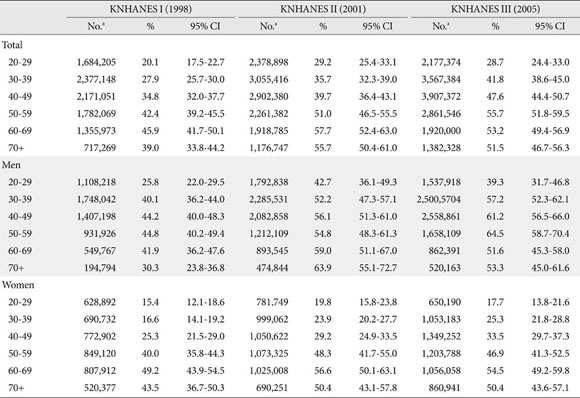
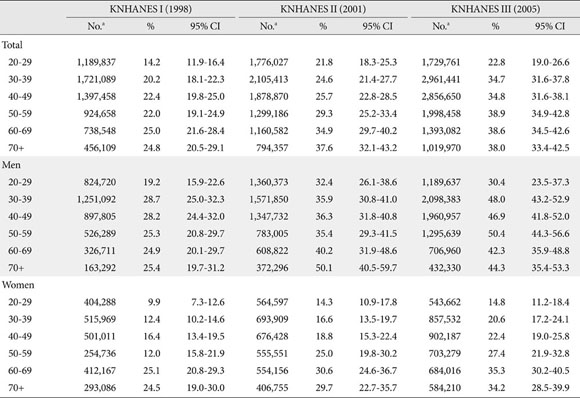
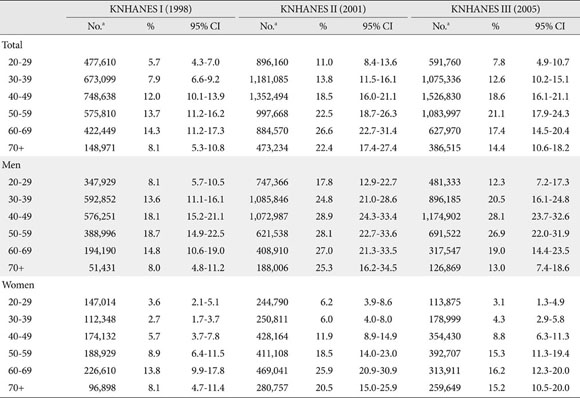
 XML Download
XML Download